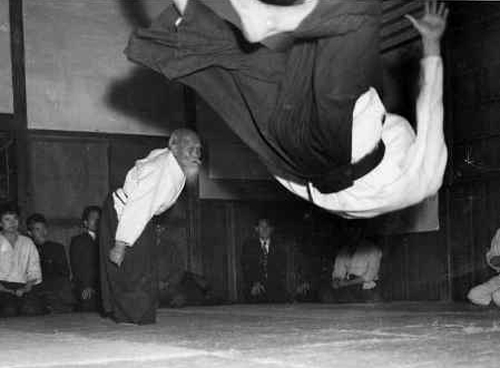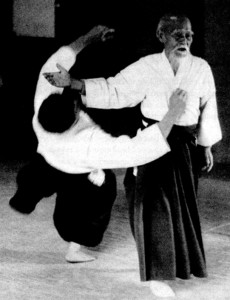
O-Sensei Ueshiba, founder of Aikido, helping a young grasshopper appreciate today's important lesson
My dad holds a brown belt in Karate, from a time when belts were earned through physical abuse, and a black belt was the culmination of a lifetime of dedication. I thank him for my love for martial arts and violent action movies. He set up a home gym, which had Bruce Lee and Sylvester Stallone posters on the walls. Part of his ab routine was to do a few hundred inclined sit-ups, followed by calling my brother and I over to punch him in the stomach. This routine didn’t last very long, because we grew up.
Next, he encouraged my brother and I to join Tae Kwon Do classes at our school. I remember us practicing Kata (patterns) in our backyard (where he also installed a heavy bag). In high school, I studied Aikido with 2 childhood friends. Later in college, I trained Brazilian Jiu-Jitsu and Submission Wrestling 3 times a week (before MMA became household entertainment).
I still remember what my college friend Matt said to me to ease my nerves for my first Jiu-Jitsu competition. It was something along the lines of, “Yes, it is scary. There are few things scarier than this. When the referee says Go, you’ll both be at the height of your nerves and at the peak of your training. Both of you will attack, using dangerous techniques once developed for war; designed to break arms and legs, dislocate joints, slam a person to the ground and constrict blood supply to the brain. It’ll just be you and him: no equipment to hide behind, no protective padding, no running away and no teammates to help you. After you experience it, nothing else will seem as scary or as difficult.”
He was right about the danger. While training, I’ve popped a rib, was dropped on my head by a world Sambo champion who “couldn’t turn it off”, injured my knees and got kneed in the groin. But some had it worse…
In one of our competitions, one of our teammates was caught a very dangerous technique — his opponent had entangled and squeezed his forearm using his legs, and in his excitement and inexperience, torqued it too quickly… so quickly that there was no time to tap (surrender) before his forearm snapped in half.
I was filming the match at that time, and I remember hearing his awkward scream (the kind you don’t expect from a grown man), followed by “… my arm!” There’s a 1 minute silence in the video after that because I was too dumbstruck to put the camera down. The emergency response crew cut through his brand new gi, stabilized his arm and rushed him away in a stretcher. He smiled to us and reassured us he was okay on his way out, but we knew he was lying because his face had turned pale.
In another competition, one of our guys applied a devastating leg lock called the heel hook on the other guy — a technique designed to isolate and apply torque to the knee and ankle joints. Little did the newbie spectators realize, they were about to get a demonstration of why we keep reminding them to be extremely careful with this move, and why it’s banned in many competitions…
The defender first tried to relieve the pressure by rolling in the opposite direction (a valid method of escape). For a split second, they rolled like an alligator thrashing its victim… but things went south when he suddenly stopped rolling. As soon as he stopped, the joint lock re-tightened… (like a spring shortening when coiled)… compressing the bones and joints and removing all slack from tendons and ligaments. This applied an unnatural amount of force to an isolated knee and ankle. The technique was crippling enough on its own… but this time there was even more force applied from the alligator-rolling…
What we heard next was a disturbing succession of: *Snap-snap-crack-kra-pop-crack-snik-snap-crunch-pop-pop* … as his knee blew up.
The two of them remained friends, but I never saw our injured teammate return to practice. Come to think of it, I don’t remember ever seeing him around campus without crutches after that.
Matt was right about how my life would change — it was as if the volume knob on my life got turned down to 1. Nothing really bothered me much since, and I felt calmer with a greater sense of humility. You can’t help but get a deep sense of respect for your training partners who challenge you and push you beyond your limit, but yet leave their egos at the door and do their best to take care to not injure you. And there’s humility from losing often… because there are always people who are better, stronger, or just show up a little hungrier.
Now I will never say any one art is better than the other, and whoever willing to defend that position is a moron. What I will say is something that’s true for any art:
All techniques need leverage to work.
The joke is that the most effective martial arts were created by weaklings, since stronger people don’t need anything fancier than brute force. Not surprisingly, one of the key tenets is: Brains overcome brawn… Leverage overcomes strength.
Here are three examples:

5′ 2″ Morehei Ueshiba invented an art that uses an attacker’s force against himself.
One: The old man on the left is Morehei Ueshiba, founder of Aikido (“the way of harmony”). He was a tiny fellow. At 21, he was rejected by army recruiters because he was shorter than the 5′ 2″ requirement. He then devised numerous routines to stretch himself an extra inch, somehow passed the entrance exam, and was recruited for the Russo-Japanese War.
Two: The founder of Brazilian Jiu-Jitsu was a small and weak Brazilian who modified and refined the Japanese Jujutsu curriculum to require less strength.
Three: Bruce Lee, founder of Jeet Kune Do, had a left leg one inch shorter than his right, and he started his martial arts foundation in Wing Chun… which, by the way, is a close-range art historically ridiculed for being invented by a woman. Bruce Lee trained in it because he was nearsighted and had trouble seeing his opponent from far away.
The list goes on.
What? You want more proof? Aren’t you a greedy cub! Good… stay curious. Okay. You’re in for a treat… because video cameras were invented in time to capture the man known as the “God of Judo” in action, before he passed away. Kyuzo Mifune was awarded the 10th dan (the highest rank) in Judo. He was one of only 15 people ever.
At the time the video below was taken, he had amassed over 60 years of experience. A sign of wisdom is not the white hairs on his head, but how his black belt had frayed and faded back to white.
In this rare video, watch Kyuzo Mifune neutralize every frustrated attempt to throw him by bigger, stronger, faster and younger men. Then, watch how he uses precision and timing to windmill them like a rag doll. (Don’t miss the part at 1:56 where he downright embarrasses his uke with a simple sidestep.)
As you watch this, remind yourself that Kyuzo Mifune was an old grandpa. How’s it possible? What’s his secret weapon?
(Can you tell I love martial arts?)
Archimedes famously exclaimed “Eureka!” in his bathtub, before running out into the streets of Syracuse naked. He was credited for discovering the fundamental principle of mechanics that states: a great weight can be moved by a small force.
Leverage.
Or summed up by Judo’s philosophy: “Maximum efficiency, minimum effort.”
Ultimately, you have finite resources — time, your ability, or the assets in your business. Leverage is how you wring every ounce of opportunity from every resource you have. It’s using creativity to shatter the shackles of your two hands and feet, and your 24 hours each day…
… like how this one retired construction worker moves anything from 2-ton blocks to buildings– even recreating Stonehenge –using nothing but his own strength, a little bit of crazy, and a healthy serving of leverage:
Leverage gives you multiplied results from your finite resources. If you’re not using leverage everywhere you can, you are squandering your precious resources.
Leverage can save you from failure. It is always the key to unlock your next level of success. Ultimately, we have the same number of hours each day — the most successful are those who use leverage best.
So… what are your levers?
There are many– big and small –in every part of your life. Just waiting for you to discover them. Many right under your own nose.
Imagine shredding your fingers trying to open a bottle with your bare hands. Now imagine how easily it pops open with a bottle opener. Whenever you notice you’re killing yourself making something work, doing something your gut tells you is dumb, it’s a hint you need more leverage. It makes the difficult easy. Brains overcome brawn, remember?
Your first lever was revealed earlier — your Spark. Use it to develop a personal narrative that is compelling to your ideal audience. Since you already have your story, you don’t have to make it up; you just have to tell it. This amplifies your affinity with your ideal clients and your mission to serve them.
Let them feel: “This is for me and me alone”, and give them a reason to demand, “I want you and no one else.”
Happy hunting for your levers.
Next: 4 more ways to multiply your success.



Add your comment: